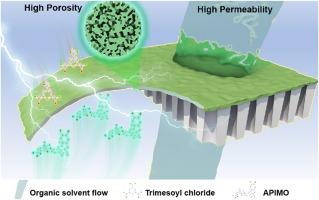用于高性能有机溶剂纳滤器的由本征微孔低聚物聚合物组成的超薄膜
IF 8.4
1区 工程技术
Q1 ENGINEERING, CHEMICAL
引用次数: 0
摘要
具有化学刚性骨架和永久微孔的微孔有机聚合物(MOPs)是制造有机物分离分子选择膜的理想材料。然而,协调薄膜加工的简便性和高微孔持久性仍是一个挑战。本文通过精确控制聚合单体的化学平衡,合理设计了一种具有固有微孔的低分子量聚合物。本征微孔聚合物低聚物将刚性和扭曲结构与水溶液加工性结合起来,通过无支撑界面聚合(SFIP)促进形成 25 纳米厚的具有增强微孔的聚芳酰胺纳米膜。由此产生的复合膜具有出色的小分子溶质截留能力和较高的非极性和极性溶剂渗透率。实验和模拟结果表明,其优异的分离性能得益于基于刚性和变形二胺的聚合物网络中形成的大量开放和相互连接的微孔,以及膜厚度的降低。这项研究为利用 MOPs 构建高微孔膜以实现精确、快速的分子筛分提供了新的视角。本文章由计算机程序翻译,如有差异,请以英文原文为准。

Ultrathin membranes comprising polymers of intrinsic microporosity oligomers for high-performance organic solvent nanofiltration
Microporous organic polymers (MOPs) featuring chemically rigid backbones and permanent micropores are desirable for fabricating molecular selective membranes towards organics separation. However, coordinating facile film processing with high micropore persistence remains a challenge. In this paper, a low molecular weight polymers of intrinsic microporosity was rationally designed by precisely controlling the stoichiometric equilibrium of polymerization monomer. The polymers of intrinsic microporosity oligomers combine rigid and contorted structures with the aqueous solution processability, promoting the formation of 25-nm-thick polyaramide nanofilms with enhanced microporosity via support-free interfacial polymerization (SFIP). The resulting composite membranes have superior retention of small molecular solutes and high nonpolar and polar solvent permeances. Experiment and simulation results show that their excellent separation performance is due to substantially open and interconnected microporosity formed in the polymer networks based on rigid and contorted diamines as well as reduced film thickness. This study provides a new sight for using MOPs to construct high-microporosity membranes for precise and rapid molecular sieving.
求助全文
通过发布文献求助,成功后即可免费获取论文全文。
去求助
来源期刊

Journal of Membrane Science
工程技术-高分子科学
CiteScore
17.10
自引率
17.90%
发文量
1031
审稿时长
2.5 months
期刊介绍:
The Journal of Membrane Science is a publication that focuses on membrane systems and is aimed at academic and industrial chemists, chemical engineers, materials scientists, and membranologists. It publishes original research and reviews on various aspects of membrane transport, membrane formation/structure, fouling, module/process design, and processes/applications. The journal primarily focuses on the structure, function, and performance of non-biological membranes but also includes papers that relate to biological membranes. The Journal of Membrane Science publishes Full Text Papers, State-of-the-Art Reviews, Letters to the Editor, and Perspectives.
 求助内容:
求助内容: 应助结果提醒方式:
应助结果提醒方式:


